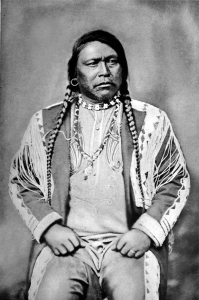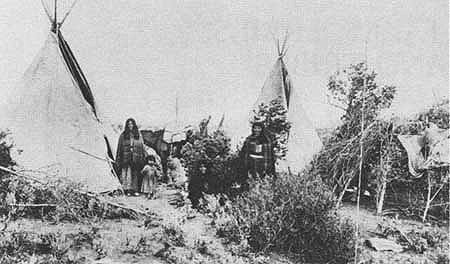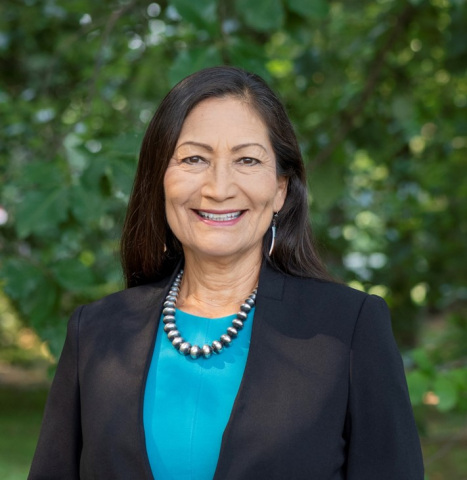
Do you know who occupied the land you call home before you did? Do you know the history of languages, religious practices, community agriculture, and conservation efforts embedded in the rock and soil under your feet? Do you know who lived, worked, died, and thrived in the mountains and valleys around you before North America was colonized, and who are still here despite the odds? In the Estes Valley of northern Colorado, today’s tourists are inundated with information about early explorers who settled here in the 1800s, including Joel Estes, Enos Mills, Isabella Bird, Abner Sprague, and Major Stephen H. Long. But as is so often the case, the Indigenous history of the area now known as Rocky Mountain National Park is comparatively incomplete and unknown.
Indigenous people have lived and traveled in this region for thousands of years. The land that is now RMNP was primarily inhabited by the Ute and Arapaho people and traversed by other tribes including the Eastern Shoshone, Apache, Comanche and Cheyenne. The Ute’s primary territory was the west side of the park near what are now called Grand Lake and Lake Granby. These people were hunter-gatherers, migrating seasonally between their summer and winter hunting grounds along the Western slope of the Continental Divide. The Arapaho originated in present-day Canada, migrated to the Great Plains due to conflict with neighboring tribes, and eventually migrated into the Front Range of present-day Colorado around 1790. They followed game into the area that is now the eastern part of RMNP, where they began to encounter the Ute.


Relations between the Ute and Arapaho were hostile, which was most likely because they had to fight for the best hunting grounds, as the Arapaho were also avid hunters. The Continental Divide separated the tribes, but we have evidence of fighting on the West side at Grand Lake and potentially on the East side near Moraine Park. The Utes also have a history of fighting with the neighboring Comanches in the 1700s before the Arapaho arrived, which was exacerbated by the firearms the Comanches obtained from the French and the horses that the Utes traded for with the Spanish.
Everything changed for the tribes when gold was discovered in Colorado in 1858, sparking the Pike’s Peak Gold Rush. Thousands of prospectors and miners entered the region quickly, causing a massive disturbance to the tribes and the beginning of the end of their territorial claims. During this time, many treaties were rapidly made and broken between the U.S. government and the Ute and Arapaho tribes. These treaties, including the Fort Laramie Treaty of 1851 and the Fort Wise Treaty of 1861, attempted to define and reduce the tribes’ territories by confining them to reservations. As the amount of gold and the number of white people rose, the amount of land the Utes and Arapahos were allowed to occupy shrunk. In 1876, Colorado became the 38th state in the U.S. By 1878, only two decades after white settlers arrived to the region looking for gold, the Arapaho had been entirely removed from Colorado and pushed onto reservations in Wyoming and Oklahoma. By the 1880s, the Ute had been pushed to the far southwest corner of Colorado and into Utah, solidifying the removal of the major Indigenous presences in what would become Rocky Mountain National Park in 1915.
Trails that were heavily used by both the Ute and the Arapaho are still actively used in the park today, including the Ute Trail, Tonahutu Trail, Flattop Mountain Trail, and Trail Ridge Road. Remnants of the tribes’ pre-colonization activities have been found throughout the park, including tools and fragments of pottery, and many of these artifacts are preserved in RMNP’s museum archives. But unfortunately, there is much about the history of this region that we will never know since the Indigenous voices were silenced and forcefully removed by white intruders that never ended up finding very much gold here anyway.


The current residents of Estes Park, the staff and volunteers of the park, and every one of the ~4.5 million annual visitors to RMNP have a responsibility to not only preserve and protect this place for future generations, but also to acknowledge the Indigenous history of the land and be respectful of the original stewards of the mountains, valleys, lakes and rivers that we now use for recreation. Educating yourself is the first step: learn about the history of the land you now occupy, read books and articles written by Native people, practice Leave No Trace, and engage in political action to return Native land to Native hands and continue reparations.
A few weeks ago, while I was working my shift at Rocky’s Beaver Meadows Visitor Center, I was fortunate enough to meet Secretary of the Interior Deb Haaland, the first Native person to serve as a cabinet secretary and one of the first Native women to serve in Congress. Secretary Haaland is a member of the Pueblo of Laguna and a 35th generation New Mexican. I was honored to shake her hand as she toured the visitor center; her work and even just her presence in the Department of the Interior is a huge step toward furthering diversity in the federal government. We have a long way to go, but Secretary Haaland is a wonderful symbol of hope in the fight for environmental justice and Indigenous leadership in the management of public lands.
To find out what Native land you live on, visit https://native-land.ca/
by Erin Tansimore,
Rocky Mountain Conservancy Winter Sessel Family Fellow
Sources:
National Park Service, Rocky Mountain National Park Time Line of Historic Events. https://www.nps.gov/romo/learn/historyculture/time_line_of_historic_events.htm
Colorado Wilderness Rides and Guides, Native American History of Rocky Mountain National Park. https://coloradowildernessridesandguides.com/education/native-american-history-of-rocky-mountain-national-park/
National Park Service, Rocky Mountain National Park, A History. https://www.nps.gov/parkhistory/online_books/romo/buchholtz/chap1.htm
Secretary Deb Haaland. https://www.doi.gov/secretary-deb-haaland
